Current Research Projects
A Machine Learning-based Intelligent Middleware Platform for a Private Edge Cloud
Colorectal Digital Twin for Early Detection and Management of Colorectal Diseases
Prior Research Projects
Private Mobile Edge Cloud for 5G Network Applications
Self-Learning Smart Ageing Service based on Web of Objects
EmoSpaces
Korean Satellite Based Augmentation System
Mobile Ad hoc Computational Cloud
Mobile Ad hoc Computational Grid
Wi-Fi Direct-based Mobile Ad hoc Network
RFID and WSN Integration
Continuous Object Detection and Tracking
Virtual Gateway
A Machine Learning-based Intelligent Middleware Platform for a Private Edge Cloud
A Private Edge Cloud is a localized, small-scale cloud data center situated in environments such as homes or offices. This system comprises a mix of stationary and mobile devices—including personal computers, smartphones, mobile robots, and sensors—interconnected via one or more infrastructure-based or ad hoc wireless local area networks. The Private Edge Cloud is characterized by a dynamic and complex multilayer network and computing infrastructure. Efficient management of this infrastructure can significantly enhance data throughput, reduce latency and traffic to core Internet networks, and mitigate data privacy risks.
To enable such management, this project aims to develop an Intelligent Middleware Platform that leverages the unique characteristics and addresses the challenges of a heterogeneous computing and multilayer networking environment. The middleware will manage and optimize the use of compute and network resources while offering services such as computation offloading, data collection, storage, and caching to support both resource-intensive and lightweight 5G and beyond 5G network applications. The proposed platform will consist of two primary layers. The first is a software-defined network and a machine learning-based multi-network management layer. This layer will integrate machine learning and SDN techniques to enhance network and application performance, provide serial and parallel data transmission services over heterogeneous networks, support dynamic allocation of multiple network interfaces, and employ machine learning-based link quality estimation and Markov chain-based link lifetime prediction to reduce communication overhead and energy consumption.
The second layer is a machine learning-based resource management. This layer will utilize regression analysis and reinforcement learning to allocate heterogeneous compute and network resources efficiently to application tasks. It will also adopt containerization and device virtualization techniques to address challenges posed by diverse execution environments and IoT device heterogeneity. Additionally, it will incorporate parallel transmission methods, dynamic interface allocation strategies, and network-level optimization techniques to accommodate the varying demands of emerging applications.
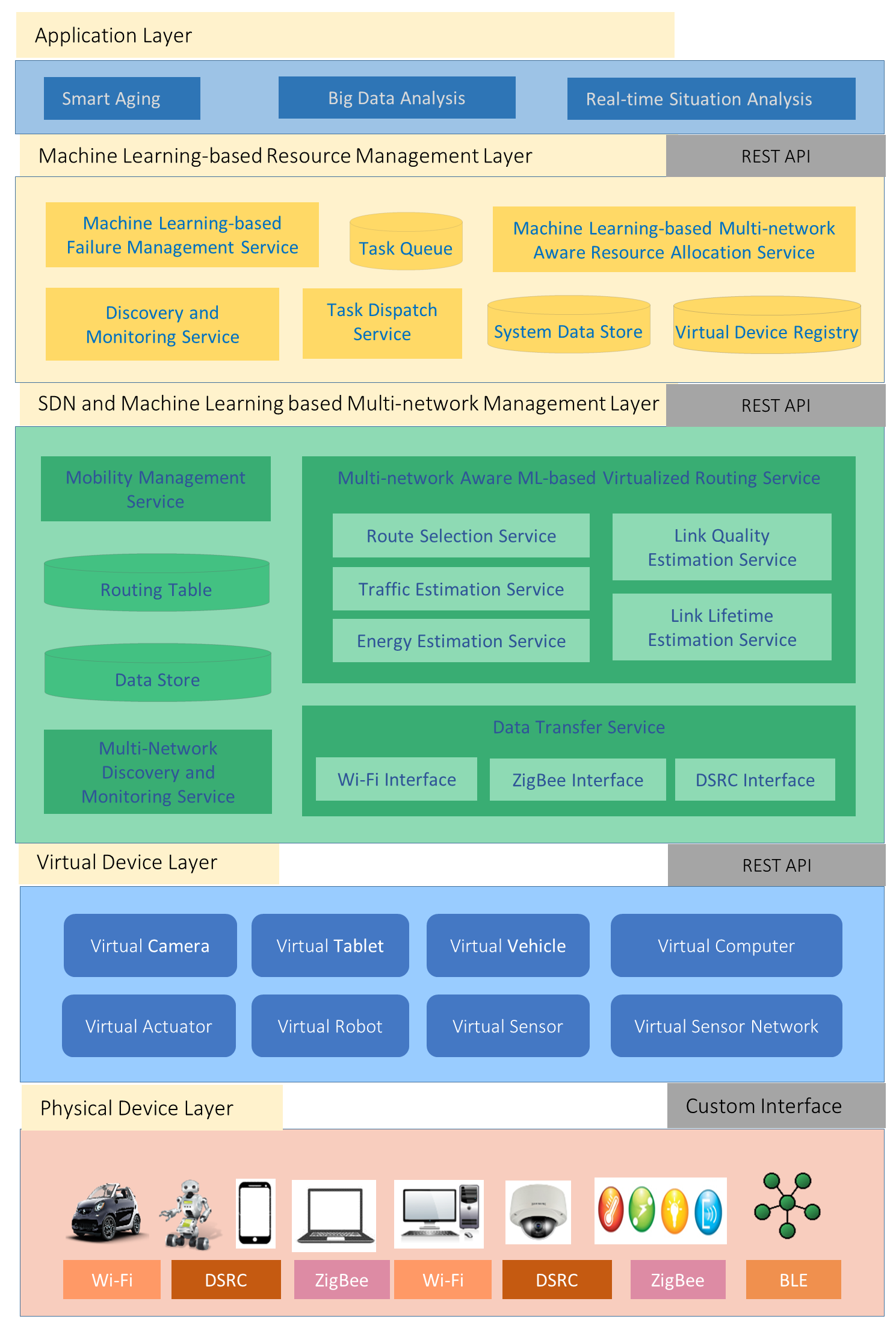
Colorectal Digital Twin for Early Detection and Management of Colorectal Diseases
Colorectal cancer, inflammatory bowel disease, and diverticular disease are progressive conditions that impact thousands of individuals worldwide. In the UK, colorectal cancer remains a significant health concern with over 42,000 new cases reported annually, leading to more than 16,500 deaths each year. Currently, there are approximately 268,000 individuals living with colorectal cancer across the country, alongside more than 500,000 individuals with Inflammatory Bowel Disease. The UK allocates 1.7 billion GBP solely for the care of colorectal cancer patients. Additionally, millions of pounds are spent on the treatment of inflammatory bowel disease and diverticular disease. The annual cost to employers due to inflammatory bowel disease is estimated at around 600 million GBP.
Early detection of these diseases can help slow their progression and reduce pain and discomfort. With timely treatment and healthy lifestyle changes, it is often possible to manage symptoms and improve quality of life.
This research aims to develop a digital twin to advance the early detection and management of colorectal cancer, inflammatory bowel disease, and diverticular disease. The specific goals are: 1) to develop a digital twin of an individual’s colorectal system to monitor and analyze both historical and current health in relation to three target diseases, and 2) to create a personalized AI agent to support early detection and management of these diseases by preventing or slowing disease progression and assessing the impact of treatments on both disease outcomes and patient health.
Prior Research Projects
Private Mobile Edge Cloud for 5G Network Applications
Resource-intensive real-time IoT and 5G network applications demand low latency, high data rates, and substantial computing and storage resources. Mobile cloud computing systems often fail to meet these requirements due to high communication latency. Recently developed edge computing solutions typically require the deployment of new infrastructure or upgrades to existing infrastructures. Moreover, edge computing approaches tend to underutilize the capabilities of end devices, which have become more powerful than supercomputers in the last decade. To address these limitations, we were developing a private mobile edge cloud in which multiple mobile and stationary devices—such as sensors, robots, home appliances, and smartphones—connected through both infrastructure-less and infrastructure-based wireless local area networks are combined to create a small-scale cloud data center within a localized physical area, such as a home.
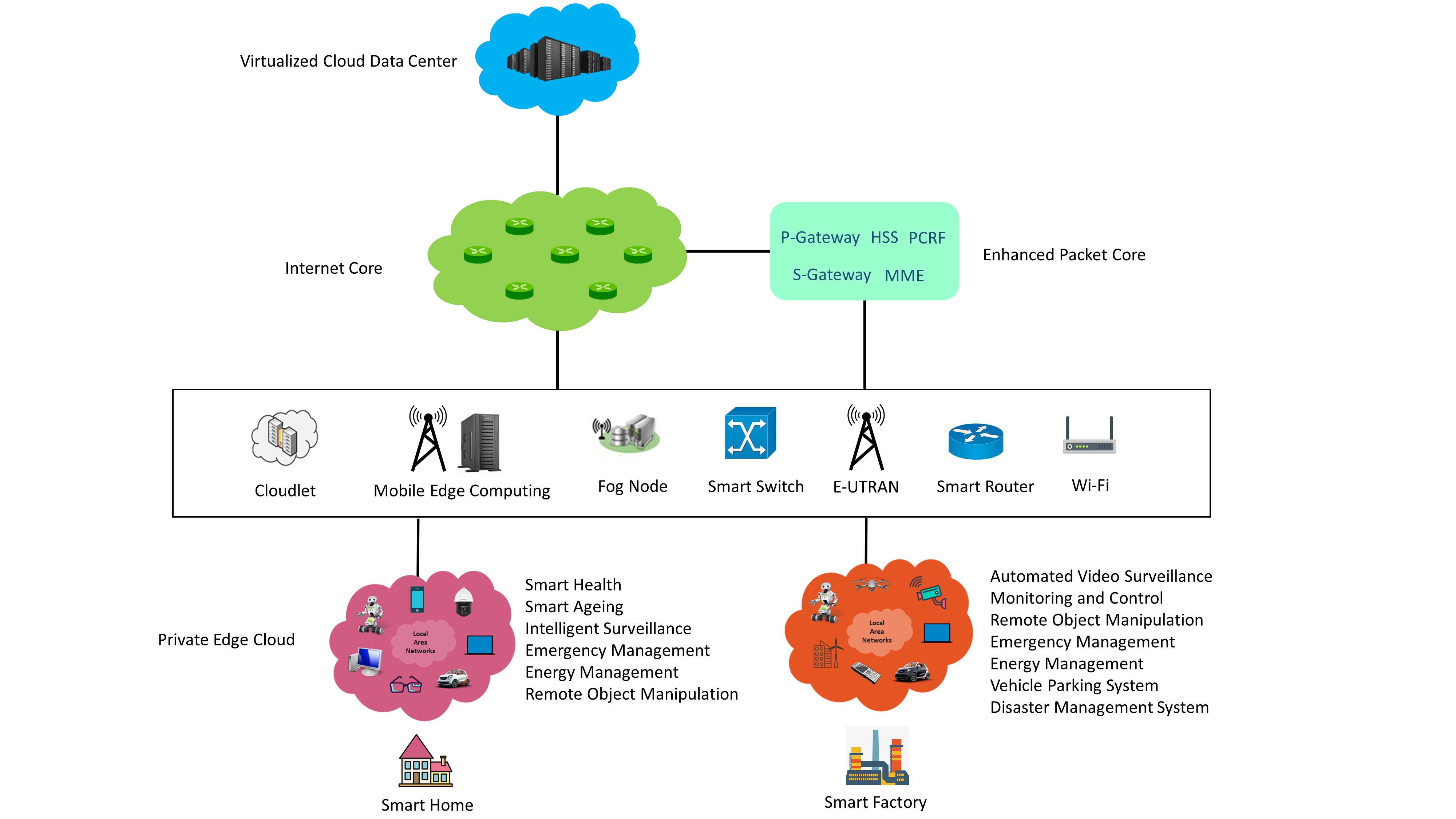
Self-Learning Smart Ageing Service based on Web of Objects
This project aims to develop technologies and mechanisms to improve the life of a super-aging society. Some of the topics we explored include representation, monitoring, and discovery of objects.
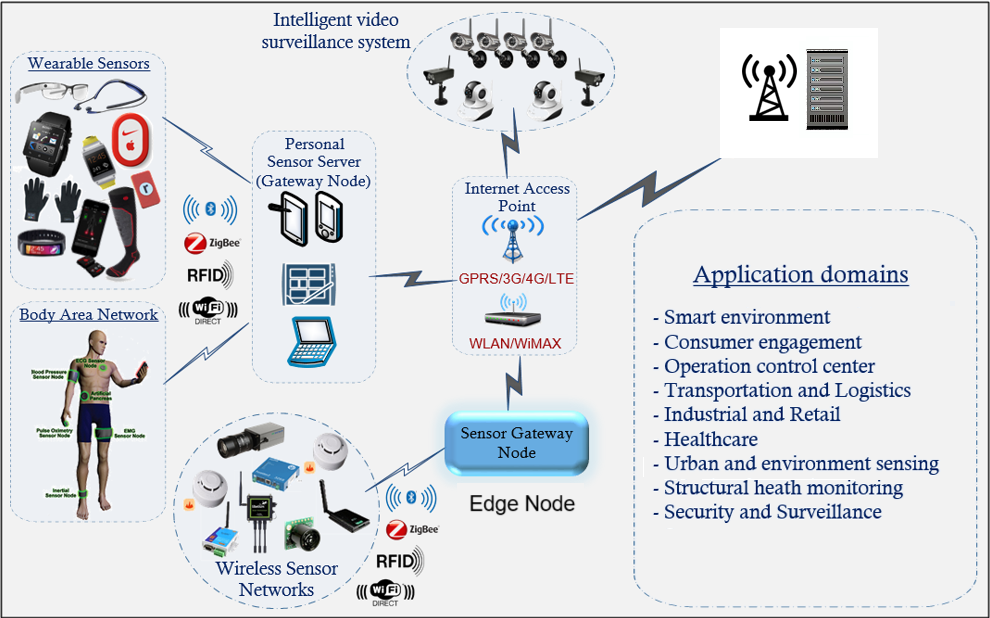
EmoSpaces
EmoSpaces’ goal is the development of an IoT platform that determines context awareness with a focus on sentiment and emotion recognition and ambient adaptation. The main innovative aspect of EmoSpaces lies in considering emotion and sentiments as a context source for improving intelligent services in IoT.
Korean Satellite Based Augmentation System
Korean Satellite Based Augmentation System was a large-scale research project funded by the Ministry of Land, Transport, and Maritime Affairs Korea. It aimed to augment the Global Navigation Satellite System by broadcasting additional signals from geostationary satellites and providing differential correction messages and integrity data for the GNSS satellites. Satellite-based augmentation system uses a network of wide-area reference stations, wide-area master station, ground earth station, and geostationary satellites. Wide area reference stations are widely dispersed GNSS data collection sites that monitor and process satellite data to determine satellite orbit and clock drift plus delays caused by the atmosphere and ionosphere. This information is then transmitted to a wide-area master station through a terrestrial communication network. A wide area master station creates correction messages and broadcasts them through geostationary satellites. The user segment receives the correction messages and applies them to improve position accuracy. The project was carried out by a consortium of seven universities and research institutes. The team at the Electronics and Telecommunications Research Institute was involved in the design and development of protocols, data processing software, and network monitoring tools for wide-area reference stations and user segments.

Mobile Ad hoc Computational Cloud
This research aims to develop a mobile distributed computing infrastructure that enables mobile nodes to share computing resources, either with pre-existing infrastructure-based systems such as the cloud, or directly with other mobile nodes using short-range wireless communication technologies such as Wi-Fi Direct.
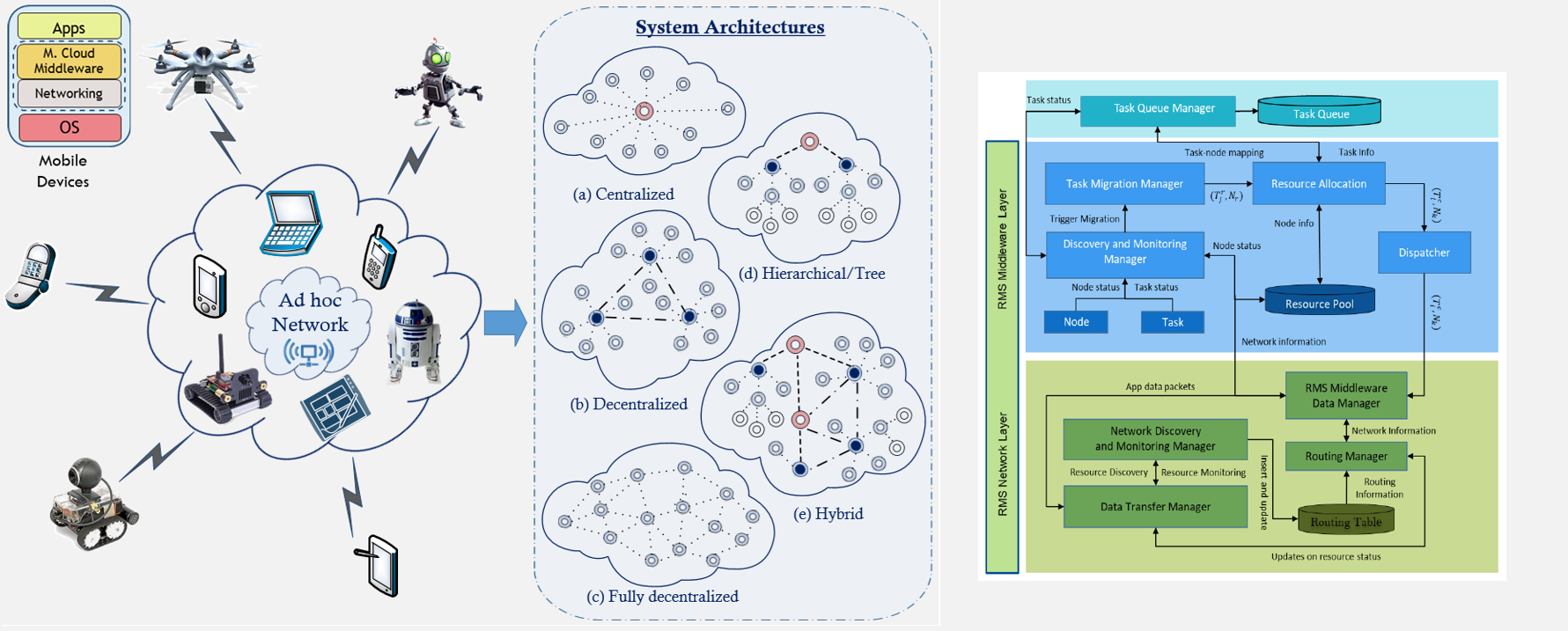
Some of the topics we worked on include the following.
Task Migration
To improve application performance, optimize resource utilization, and prevent task failure or load imbalance, an effective and robust migration strategy is essential. Designing such a strategy for mobile ad hoc clouds is challenging due to the dynamic and unpredictable network environment, unlike traditional infrastructure-based systems. The most common approach estimates the migration cost and predicts task completion time before and after migration. However, accurately estimating migration cost is particularly difficult for data-intensive tasks. Furthermore, this strategy assumes prior knowledge of the amount of data to be transmitted or processed by a task. Without this information, designing an effective migration strategy becomes even more complex.
Power Management
Nodes in a mobile cloud are battery-driven and have limited power, which must be managed efficiently to prolong both node and application lifetimes. Major sources of energy consumption include CPU processing, memory usage, and network data transmission. In particular, transmission energy depends on the power required to send data and the communication cost induced by data transfers between tasks. Inefficient resource management can significantly increase communication and energy costs, potentially causing node failure. While existing approaches primarily focus on conserving processing energy, reducing energy consumption for data transfers, especially in data-intensive parallel applications, remains an open challenge. To address this, we proposed an energy efficient resource allocation scheme for interdependent, data-intensive tasks in a mobile ad hoc computational grid. The scheme exploits transmission power control and allocates interdependent tasks to nodes that can communicate at minimum transmission power.
Mobility Management
Node mobility in mobile ad hoc clouds can be classified as global or local. Global node mobility refers to movement across the coverage area, which can cause one or more tasks to fail and may also lead to outdated resource information. Local node mobility, on the other hand, refers to movement within the coverage area and can increase data transfer costs, thereby extending task completion time. Task migration or reallocation strategies can mitigate failures caused by mobility, but these approaches introduce additional delays and can further increase task completion time. Addressing the problem of outdated information requires continuous resource monitoring, which raises communication costs. Alternatively, querying resource status during decision-making can reduce monitoring overhead but introduces additional latency.
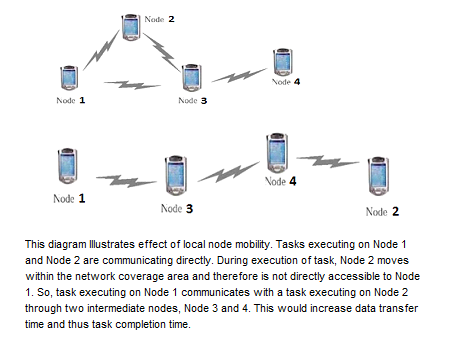
Parallel Programming Model
The programming model provides an abstract view of a computing system. Traditional parallel programming models do not handle communication challenges effectively and are therefore unsuitable for mobile ad hoc environments, where communication latencies and link failure or activation rates are high. Actor-based programming models are a promising alternative, as they handle high latencies efficiently, support lightweight task migration, and can be readily adapted to address node mobility.
Mobile Cloud Architecture
Different architectural designs present distinct advantages and trade-offs. For example, centralized architectures benefit from effective resource allocation due to a global network view but suffer from scalability issues and single points of failure. In contrast, fully decentralized architectures eliminate these issues but may produce suboptimal resource allocation decisions due to the lack of a network-wide perspective. This research aims to develop an energy-efficient, robust, and high-performance architecture capable of delivering optimal performance across a wide range of mobile ad hoc cloud scenarios.
Incentive Mechanism
Mobile ad hoc clouds are useful in various scenarios, such as battlefield and disaster relief operations. Consider a situation where an individual traveling with strangers requires additional computing resources for a computationally intensive task. The challenge is motivating individuals to share their resources with strangers. Existing solutions in the literature rely on trading battery power or processing cycles, but these are effective only when both parties need resources from each other. Moreover, ordinary users often find these resources unattractive. To address this, a new, compelling incentive mechanism is needed. Designing such a mechanism for mobile ad hoc clouds is particularly challenging due to the lack of central authority and the open, ad hoc system architecture.
Transport and Routing Protocols
This research includes the development of adaptive transport and routing protocols tailored for mobile ad hoc clouds. Such protocols aim to reduce energy consumption, for example, through multi-hop communication or transmission power control, without violating task deadlines. They may also employ multiple routes when networks become unstable. Additionally, these protocols interact with cloud and mobility management systems to provide reliable and robust services.
Wireless Communication Technologies
A variety of wireless communication technologies, such as Wi-Fi Direct and Bluetooth, are available for data transfer in ad hoc networks, each with unique characteristics. Modern devices often support multiple connection types simultaneously, enabling dynamic switching between them. To ensure efficient and reliable data transmission, further research is required to investigate and integrate suitable wireless communication technologies into mobile ad hoc computational clouds.
Mobile Ad hoc Computational Grid
The mobile ad hoc computational grid project was motivated by recent advances in mobile computing and communication technologies, which have made it feasible to design and develop next-generation applications, such as intelligent mobile video surveillance, through sharing of computing resources in a mobile ad hoc environment.

Resource management is a central task in any parallel and distributed system. Compared to traditional distributed systems, mobile ad hoc computational grids are characterized by a shared and unreliable communication medium, node mobility, limited battery power, and an infrastructure-less network environment. Therefore, resource allocation schemes designed for traditional distributed systems are not applicable. In this research, we developed several resource management schemes tailored for mobile ad hoc computational grids. Many of the issues addressed in this research are also applicable to related areas such as mobile P2P networks and vehicular ad hoc networks. Key schemes developed in this research are listed below.
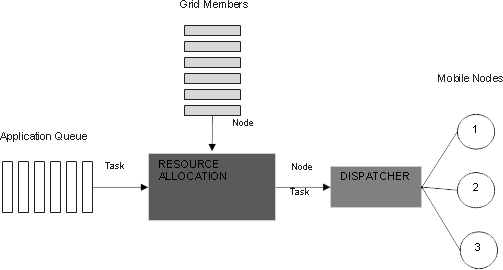
Energy Efficient Resource Allocation
Energy efficient resource allocation is a critical design criterion due to the limited battery life of nodes. The primary sources of energy consumption include CPU processing, memory usage, and data transmission within the network. Key factors contributing to transmission energy consumption are the transmission power required to send data and communication costs induced by data transfers between tasks. In this research, we developed several resource allocation strategies aimed at reducing energy consumption caused by data transmission between data-intensive dependent tasks. The core idea was to allocate data-intensive dependent tasks to nodes accessible at minimum transmission power. Additionally, we proposed a hybrid architecture that enables effective allocation while reducing the processing burden on individual nodes and communication costs associated with the exchange of control information.
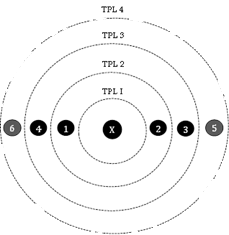
Effective and Robust Resource Allocation
The performance of parallel applications depends heavily on selecting reliable nodes, which is particularly challenging in mobile ad hoc computational grids due to node mobility. To address this challenge, we developed a Markov-based mobility model that exploits the history of users’ mobility patterns. Furthermore, we identified open issues and challenges in developing a robust and effective resource allocation scheme and proposed a set of novel resource allocation policies that consider both the characteristics of applications and the dynamic, distributed nature of mobile ad hoc computational grids. We also analyzed the performance of the transport, routing, and medium access control layers and identified key issues that degrade the performance of parallel applications and ad hoc computational grids.
Energy Efficient and Robust Resource Allocation
This research addressed the challenges of power consumption and node mobility in mobile ad hoc computational grids, aiming to reduce data transfer times between dependent tasks and the energy consumed during data transmission. It also investigated the impact of lower-layer protocols on data transfer times and energy consumption. Extensive simulation results demonstrated that the proposed policies significantly reduce energy consumption, although their performance in terms of application completion time depends on node deployment and application configuration.
Wi-Fi Direct-based Mobile Ad hoc Network
Existing mobile ad hoc network technologies offer limited bandwidth and are therefore unsuitable for data-intensive applications such as automated video surveillance. Wi-Fi Direct is an emerging technology that allows mobile devices to communicate directly with each other without relying on a wireless access point. Compared to existing technologies, it provides data rates of up to 250 Mbps, which is sufficient for many mobile data-intensive applications. However, Wi-Fi Direct has two main limitations: it does not support communication between two client devices within a group, and it lacks support for multi-hop communication—a critical requirement for several IoT and mobile cyber-physical system applications. This research aims to develop an energy-efficient and robust Wi-Fi Direct-based multi-hop mobile ad hoc network.
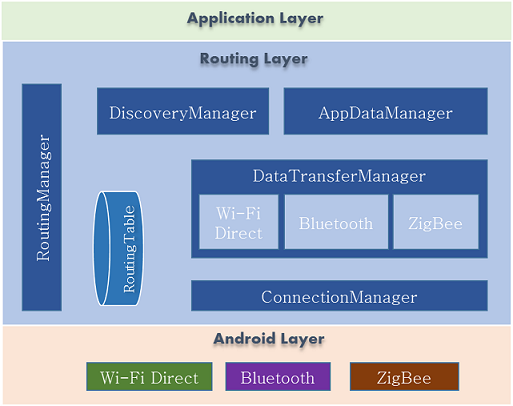
RFID and WSN Integration
Radio Frequency Identification (RFID) and Wireless Sensor Network (WSN) are backbone technologies for pervasive environments. RFID is used to detect and identify objects while WSN provides contextual information about an object by collecting sensory data. The integration of both technologies aims to offer identification as well as contextual information of an object which enables numerous applications in areas of context-aware and smart environments. One of the main problems that this integration introduces is data redundancy. RFID data contains a lot of duplication due to readers' overlapped reading areas and readers’ multiple read cycles which consume network resources and transmission energy. In this research, we explored architectures and application environments enabled by the integration of RFID and WSN and developed several in-network RFID data filtering schemes to minimize the amount of redundant data and energy consumption.

Continuous Object Detection and Tracking
Wireless sensor networks have been used in a wide variety of applications, ranging from environmental monitoring to military surveillance. Object detection and tracking are key issues in these applications. Objects to be tracked can be classified into three categories: single objects, multiple objects, and continuous objects. Continuous objects such as forest fires, biochemical materials, and oil spills differ from single and multiple objects in that they are continuously distributed across a region and usually cover a large area. In addition, they tend to diffuse, increase in size, change in shape, or even split into multiple relatively small continuous objects over time. These characteristics along with the limited capabilities of sensor nodes pose numerous challenges in the design and development of detection and tracking algorithms. This research aimed to develop real-time and energy-efficient algorithms for the detection and tracking of continuous objects.
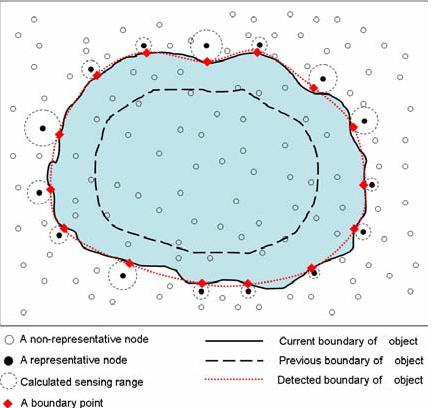
Virtual Gateway
Connectivity to a fixed network relies on gateway nodes within a mobile ad hoc network. Failures or mobility of these nodes can disrupt communication and degrade performance. Virtual Gateways provide fault-tolerant connectivity, ensuring reliable and continuous interaction between the MANET and the fixed network despite node failures or movement.
